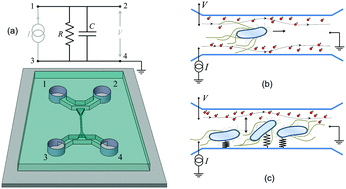Microfluidic detection of movements of Escherichia coli for rapid antibiotic susceptibility testing†
Abstract
Various nanomechanical movements of bacteria provide a signature of bacterial viability. Most notably, bacterial movements have been observed to subside rapidly and dramatically when the bacteria are exposed to effective antibiotics. Thus, monitoring bacterial movements, if performed with high fidelity, could offer a path to various clinical microbiological applications, including antibiotic susceptibility tests. Here, we introduce a robust and ultrasensitive electrical transduction technique for detecting the nanomechanical movements of bacteria. The technique is based on measuring the electrical fluctuations in a microfluidic channel, which the bacteria populate. The swimming of planktonic bacteria and the random oscillations of surface-immobilized bacteria both cause small but detectable electrical fluctuations. We show that this technique provides enough sensitivity to detect even the slightest movements of a single cell; we also demonstrate an antibiotic susceptibility test in a biological matrix. Given that it lends itself to smooth integration with other microfluidic methods and devices, the technique can be developed into a functional antibiotic susceptibility test, in particular, for urinary tract infections.



 Please wait while we load your content...
Please wait while we load your content...